The Great War (mod 1914)
- Thread starter Kurt_Steiner
- Start date
-
We have updated our Community Code of Conduct. Please read through the new rules for the forum that are an integral part of Paradox Interactive’s User Agreement.
You are using an out of date browser. It may not display this or other websites correctly.
You should upgrade or use an alternative browser.
You should upgrade or use an alternative browser.
Meh, until they combine that railroad gun with the tanks I'm not impressed.

And if that thing's turreted - what is it, the proposed Ratte? - it traverses at about one degree a day...
Chapter fifity-seven: "Where's Johnny Turk?"
After the fall of Jerusalem, the Allied fortunes in the Middle East and Mesopotamia went so well that the Allied war effort almost died of success. In Palestine, the Ottoman army collapsed and its units began to withdraw in all directions in such a chaotic fashion that General Allenby suspected that a trap was in order. It took him three months to reach Damascus.
It began with an unexpected surprise when an "Arab" arrived to Cairo, where he met Brigadier-General Gilbert Clayton. Clayton had risen to the rank of brigadier general in the General Staff, Hijaz Operations, and became chief political officer to Allenby. Clayton, who in 1914 wrote a secret memorandum to Lord Kitchener suggesting that Arabs could be of service to Britain during the war and that an Arab leader friendly to Britain should be made caliph in place of the Ottoman sultan, had the shock of his life when he discovered that the "Arab" was T.E. Lawrence, the British liaison officer serving with Emir Feisal. First Clayton was astonished by the Arab robes that Lawrence wore and then by the news that the British officer brought him: the Arabs had conquered Aqaba. Lawrence asked for arms, ammunition and, crucially, money and explained to Clayton his hopes of an insurrection in eastern Syria that could destabilise the Turkish Army’s communications and intensify the ordeal of the Turkish garrison at Medina.
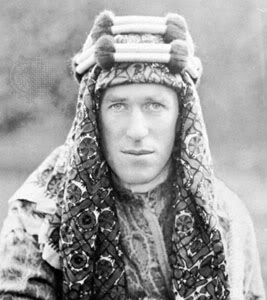
El Aurens: T. E. Lawrence
When told about this, Allenby, impressed by the Arab Revolt, decided to support them. As he remarked to Lawrence ‘I will do for you what I can’. However, Allenby wondered what he could do. Lawrence had told him that he could disrupt the Turkish Army. However, Allenby knew that most of the Ottoman forces in Palestine where, already, quite disrupted by the British advance to Jerusalem. Worse still, he knew that, in spire of what the pro-Arab section of the Foreign Office might say about it, nobody in No 10 -or even in Paris- would enjoy too much seeing the Arabs conquering Damascus. Thus, he decided to use the Arab Revolt to his advantage.
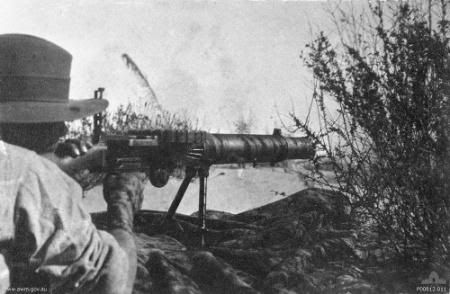
An Australian soldier firing a Lewis Gun during the Battle of Magdhaba
Of course, he send funding to Lawrence and stressed the importance of mounting raids on the Hejaz railway. Then the second surprise came. After the capture of Jerusalem, the War Cabinet asked Allenby whether the offensive against the Turkish Army could be resumed immediately. Allenby replied that his army required recuperation after the gruelling advance through Palestine: the EEF required reorganisation, the improvement of Palestine’s woeful railway lines and the development of Jaffa’s docking facilities to simplify supply arrangements. However, reality struck Allenby. His caution proved to be inadequate for the War Cabinet, which desired a more dramatic advance against the Turkish Army in Palestine. To achieve that, Allenby replied, he needed reinfrocements. Of course, the CIGS said no. Robertson argued that any conceivable benefits from the campaign in Palestine had already been extracted, and that a defensive stance was advisable. Reinforcing the EEF would divert precious manpower and resources from the BEF in France and Flanders, where, according to Robertson, the war was goin to be won. He added that the occupation of Syria was likely to demand the presence of a large British garrison force, and opined that the conquest of Syria would pose no threat to the Ottoman Empire.
Fate intervened then. Lt. Gen. Sir Ivor Maxse, CO of the XVI Corps, was informed on the morning of December 1st, 1916, that there were no enemy troops on the way to Haifa. After consulting with Allenby about "scouting what lay in front of the boys", Maxse moved all his corps towards Haifa and reached it without too much adoo. In fact, he soon moved towards the Golan's Heights, facing no opposition. When he informed Allenby of this, the stunned British general fired back "Are you sure where you are?". Bitting his lips and refraining from wiring back "come and see for yourself", Maxse confirmed that he had reached Damascus and, besides some camels, he could see nothing standing between Damascus and him. Thus, after a baffled Allenby replied "go then", Maxse's vanguard moved to the Syrian capital, which, after securing Deraa, was reached by December 19th, 1916.

It must be said that, finally, the Turkish army fought. The Ottoman's Last Stand took place in Damascus, and was a sad affair. Three depleted divisions digged in around the city when the XVI Corps arrived. As soon as the British gun fired, the Ottomans fled. If Maxse had had some mounted troops with him, the Turkish rout could have turned into a nightmare. In this quite not too "epic" way Damascus was freed by the British. Two weeks later, Allenby's forces crossed the Jordan, conquered Amman and linked with the British army in Mesopotamia, that had freed Karbala and Mosul, while Maxse pressed towards Beirut. In this operation, mounted troops made good progress along the barely adequate roads in the notably dry conditions, supported constantly by the few units of the Royal Flying Corps alloted to Allenby's EEF. One of the most ludricrous moments of the Amman Campaign came a few days before the city was taken, when the 4th Battalion of the King's Own Scottish Borderers reported that its advance had been stopped by the enemy, "somehow, at least". As a kind of explanation, the KOSB's CO added: "Impossible to advance. STOP Too busy with Turkish POWs END". The capture of Amman and the cutting of the Hejaz railway dealt a weighty blow to the Ottoman Empire in the Near East. Control of the Arabian Fertile Crescent was slipping from her grasp.
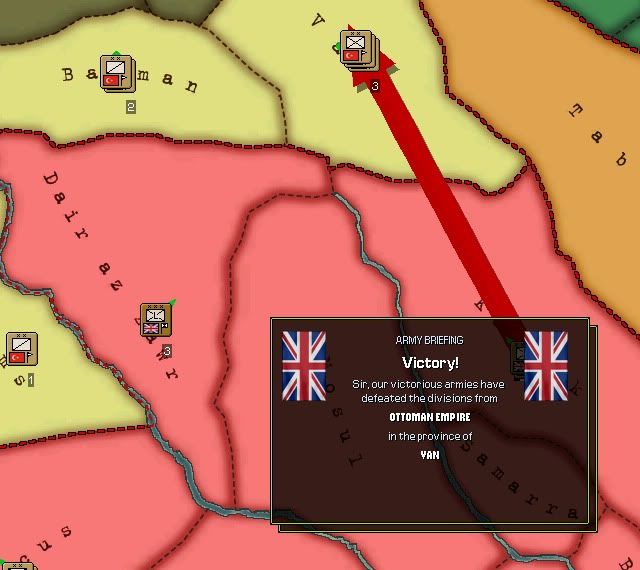
In Mesopotamia, The CO of the MEF, general Sir Charles Monro, had the same problem that had befell upon Allenby. Since the fall of Bagdad in September 18th, 1916, he had little problems with the Ottoman army. The enemy, simply vanished when his troops began to advance. Thus, by late 1916, he had freed most of Irak and was at the gates of the Kurdistan, where the Ottoman army attempted to stop his advance with little success. And then, what the enemy could not do, logistical troubles managed to achieve: the MEF had to stop.
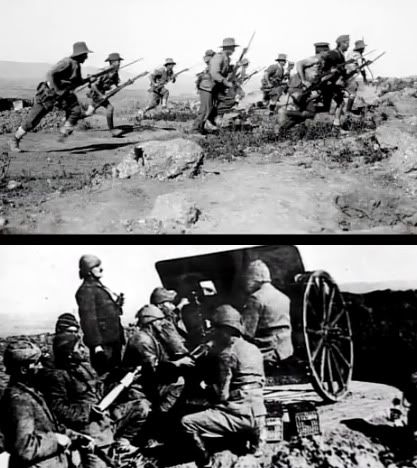
When the Australian charged, they usually encountered no resistance or a just a few guns that, after firing some shells, retreated as if the Devil was after their skins
In Jerusalem, the careful plans prepared by Brevet Brigadier-General Archibald Wavell, became outdated by the fast pace of advance of the EEF: Beirut fell on January 14, 1917, and Tripoli was next on the list. Meanwhile, the Australian and New Zealander divisions were forcing the Ottoman forces surrounded south of Jerusalem and Damascus to withdraw into the Hejaz, where Feisal's Arabs waited for them with their knifes ready. Between January and March 1917, 70,000 Ottoman troops where forced to withdraw into the Hejaz. Just a few of them returned to their homes after the war was over.
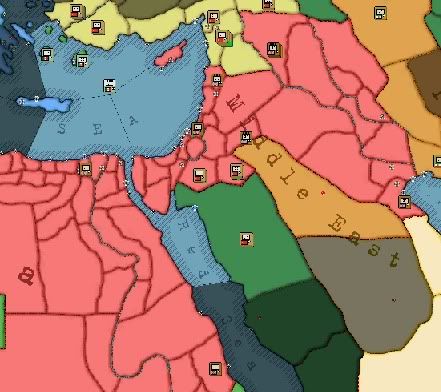
@MastahCheef117: Laugh, laugh, but let me tell your something: without them, this war might have lasted for too long...
@Nathan Madien: Let me guess, Nathan: have you ever seen a St. Chamond tank?
@Enewald: It's part of a clever idea to land without being noticed in Finland.
@trekaddict: To Berlin and yonder beyond!
@c0d5579: No idea. It flew a bit during the trials, but it wasn't too impressive.
@quaazi: The tank that resembles more to that concept it's the Mk I with the 60 lbs guns or the 152 mm howitzer... Perhaps the awful Flying Elephant...
@Nathan Madien (2): Adolf had odd habits...
trekaddict: And I the Centurion, so it's not me, either
@c0d5579 and @trekaddict (2) see MastahCheef117
@MastahCheef117: bigger, more powerful and even a bigger waste of resources than the Ratte.
Last edited:
Is it Russians in Van?
if yes give them anatolia or bosporus and give western anatolia coastline to greeks cyprus and lebanon too
glory to Queen, Tzar and Spar... ekhm Brave Ellas!
nice to see Lawrence, it's sad he didn't live up his natural death...
if yes give them anatolia or bosporus and give western anatolia coastline to greeks cyprus and lebanon too
glory to Queen, Tzar and Spar... ekhm Brave Ellas!
nice to see Lawrence, it's sad he didn't live up his natural death...
Wow, this AAR is popular enough to attract spambots!
Gratz Kurt!
Revenge of the Turk? :rofl:
Gratz Kurt!
Revenge of the Turk? :rofl:
Aren't you worried about the ethical side of giving Euthanasia to the Terminal Weak Man of Europe?
But as long as you don't put Lawrence on a motor bike, I think not even Batman would be able to save the Sultan's behind.
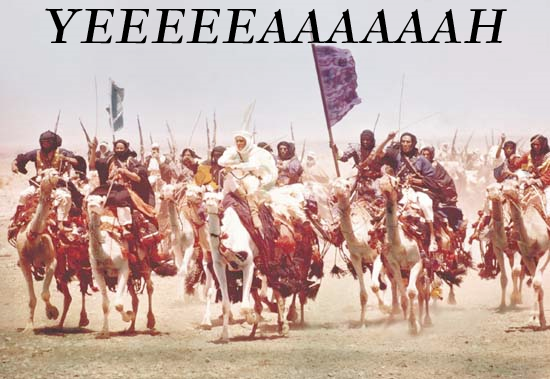
But as long as you don't put Lawrence on a motor bike, I think not even Batman would be able to save the Sultan's behind.

Aren't you worried about the ethical side of giving Euthanasia to the Terminal Weak Man of Europe?
But as long as you don't put Lawrence on a motor bike, I think not even Batman would be able to save the Sultan's behind.
The British are closing on Batman.
Ethical side? British imperialism?
Imagine a Ratte during WWI. Or better yet, employed in the Middle East against the Ottomans. Fun 
I dunno, given how easily they broke down, I'd say in France near a reasonable maintenance infrastructure is a much better place for them than roasting men alive in the Mideast where once a day around four in the afternoon they'd get buried in the daily dust storm.
God, yes. Given that in the first tanks, the engine was right there in the crew compartment, with no shielding, no silencer and barely any ventilation, then if you tried to use a tank in the Middle East you'd have to stop every ten minutes to pull out the crew who'd all died of heat exhaustion, and tell another crew to climb in...I dunno, given how easily they broke down, I'd say in France near a reasonable maintenance infrastructure is a much better place for them than roasting men alive in the Mideast where once a day around four in the afternoon they'd get buried in the daily dust storm.
(Or, true story, you do what one British tank crew did on the Western Front - start their tank, point it at the enemy trenches, wedge down the controls, then get out and walk along behind the tank as it clanked forward...)

